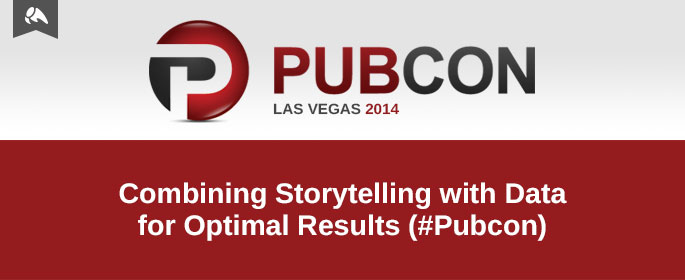
Are you creating stories without any data to back them up?
Are you using hard data to inform all decisions, without any human element?
Stop.
Pubcon Las Vegas 2014 kicked off day 2 with a keynote session by Jeffrey Eisenberg, co-author of soon-to-be-launched (October 27) ebook “Buyer Legends: The Executive Storyteller’s Guide.”
Buyer Legends is the business process by which Jeffrey and Bryan Eisenberg want you to take your emotional storytelling and combine it with the hard data you have collected to “find new opportunities, spot gaps, optimize sales and optimize marketing.”
Why is this process important? “It aligns strategy to brand story to the buyer’s actual experience on their customer journey.” That’s critical. More and more integrated agencies are understanding the need to align the creative ideas with the analytical tools and insights we have available.
You can’t just rely on creative brand stories.
Today, we have so much data at our fingertips to inform us about our target audience. We’ve used this data to create personas, or composites. They provide us with our customer’s motivations, knowledge, needs, purchasing habits and preferences. They allow us to put on the persona of the character we’re trying to make act. They guide us to transform ourselves into someone else, if done correctly. Creating stories without using data can leave you subject to creating stories that have no relevance. These stories don’t cause people to act. They don’t convert.
But you can’t just rely on data.
“The problem with hard data, the quantitative universe, is that we actually repress the ability to put ourselves in the shoes of our customers.” – Jeffrey Eisenberg.
When data is the only influence, we lose the emotion and the relatability. We lose the human element. And you can’t do that, because your conversion rate is the measurement of your ability to persuade visitors to take the action you want them to take. You can’t lead someone to a friendly customer-focused landing page only to have them click to a cold, conversion-halting form. Context and flow must be maintained.
“It’s a reflection of your effectiveness and customer satisfaction. For you to achieve your goals, visitors must first achieve theirs.” – Bryan Eisenberg, ClickZ, 2011.
Combine data and storytelling to create your marketing campaigns.
Jeffrey Eisenberg spoke to the success of Amazon. At Amazon, nobody presents in bullet points. Nobody relies solely on PowerPoint-like slides to share results or plans. At Amazon, you have to write your strategies out in full sentences (or paragraphs) to complete your thoughts with deeper clarity. By forcing ourselves to write out our strategies and our results, it forces us to explore our strategies in more depth. We’re able to identify “weak thinking” and understand what needs to be altered or developed more.
How do you develop that well thought-out plan? Eisenberg recommends beginning with the following:
Understand your perspective: Identify your outlook, your purpose, your goals.
Conduct your pre-mortem: Identify everything that could go wrong or detour the visitor from your intended outcome.
Explore your reverse chronology: Start with the conversion and work backwards. When you tell a story going forward, it’s a series of “and this happened, and then this happened.” When you tell it backwards, you see the forks in the road. You identify what else could have happened, and identify why they make the choices they did.
Then spend time drafting your plan based on the research you’ve already done and the data you already have, considering key elements such as:
- The people you are trying to reach
- Their (your target audience’s) purpose and objective
- The sequences of steps in their planning
- The rationale for their plan
- Key decisions they are making
- Emotional struggles that affect decision-making
- Anti-goals – what do you not want to happen?
- Constraints and other considerations – things that will affect your plan and what you can achieve
- Reasonable alternatives for your target audience
- The way in which you will measure your results
By planning your strategies with the above in mind, you can execute more customer-centric campaigns that engage your consumers and convert.
More to come from Pubcon Las Vegas 2014 – tweet @overit and meet up with us!







